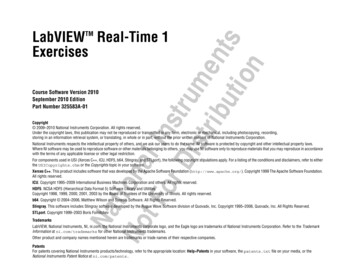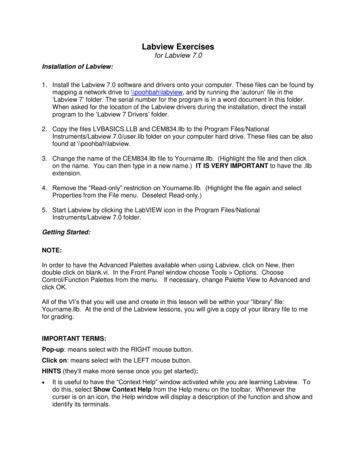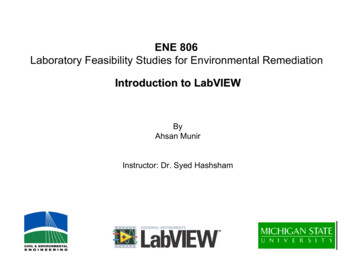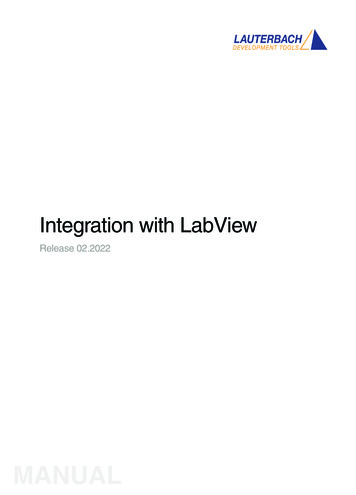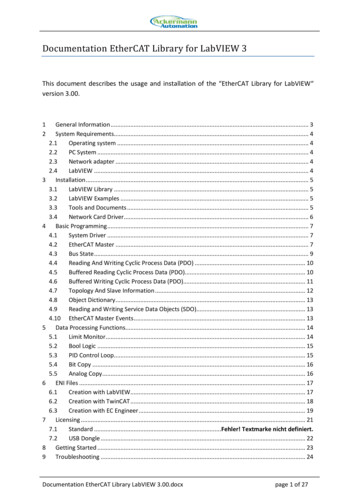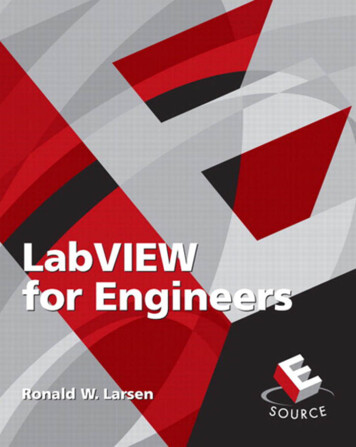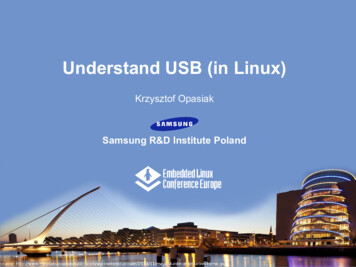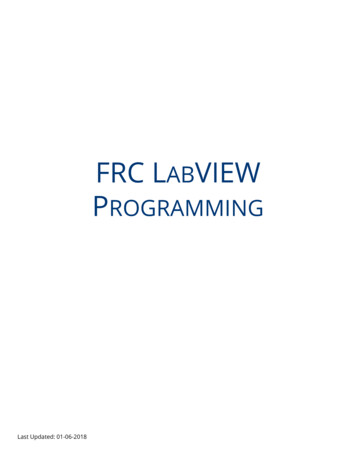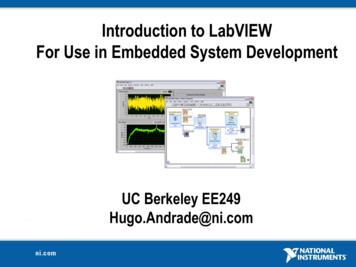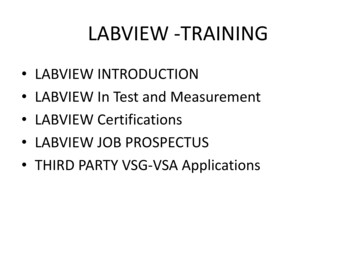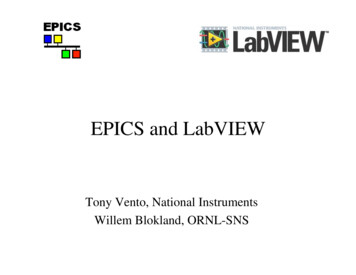
Transcription
EPICS and LabVIEWTony Vento, National InstrumentsWillem Blokland, ORNL-SNS
Graphical dataflow programming Interactive front panel / GUI Efficient compiled execution Targets Windows, Real-Time, FPGA,Linux, Macintosh, DSP, OtherProcessors I/O and analysis libraries Distributed networking capabilities
EPICS and LabVIEW Interfaces(Oak Ridge and Others)1. Shared Memory Interface to IOC (I/O Channel) Links LabVIEW and IOC Process Variables (PVs) Data from LabVIEW is available to the IOC Windows2. CA (Channel Access) Client LabVIEW as a display environment for PVs No programming required Windows, Macintosh, Linux
1. Shared Memory Interface db & cmd file generatorat startup Development tool-Cloning/documentationWindows PCApplication Shared Memory Records LabVIEW Library(D. Thompson)Template toolsLabVIEWShared MemoryEPICS IOC CAChannel Access Standard Examples NADs implemented:BCM, BPM, ES, FC, TTS(M. Sundaram, C. Long, W.Blokland, LANL, BNL)Graphical programming Drivers to DAQ Processing routines Graphs/PlotsAccelerator Controls
Shared Memory InterfaceShared Memory IOC written byD. Thompson. LabVIEW Libraryby W. Blokland.The shared memory interfacebuffers the data and implementsfunctions to: Create, find and destroyvariables Read from and write tovariables Set and receive events Retrieve information aboutvariables
Program startup1.2.3.4.LabVIEW loads and runs Top-Level VILabVIEW gets variable declarations, generates .db and starts IOCIOC starts and loads db file. Each time the IOC creates a PV record,the record creates a Shared Memory (SM) entryLabVIEW finds references to SM entries by resolving PV names
EPICS dB UtilityThe dBGenerate Utility automatically generates the database file for theEPICS IOC as well as the cmd file and an Excel file. The utility uses theVI that resolves names to indices, as written by the programmer, asinformation on which PVs are going to be used. The utility supports theinstantiation of one device many times (necessary for the NAD concept).
PerformanceTESTWriting 4096 doubles andsetting interrupt to processvaluesWriting 1024 doubles andsetting interrupt to processvaluesProfiler80 usec ( 10 usec) 20 usec( - 5 usec)67 11Total program270 usecComments(2Ghz P4) no client130 usec ( -10usec)Profiler: times measured with LabVIEW’s profiler tool,excludes all time spent by processor elsewhereTotal: use time before and after execution, includes alltime spent by processor on other processes.
Template: State Machine
Template: State Machine diagram
TemplateUse templates (state-machine based) to:1) Strict organization - clear development path2) Similar structure among instruments- re-use of code withcopy/rename tool3) Simple structure - fast development and debug4) Built-in support for user-interface/EPICS/ configurationfiles.5) State machine supports jumps to other state if exceptionoccurs (e.g. error condition)Network Attached Device: Each pickup or sensor has its own resources such astiming, data acquisition and processing. No tightly coupled systems Anindividual device can fail or be serviced without disrupting other devices.Software is simplified as it doesn’t have to manage single resources amongmultiple devices.
Diagnostic NADs(Network Attached Device)InstrumentBeam Position LinacBeam Position RingWire ScannerTypeIOCIOCCABeam StopBeam ApertureFaraday CupArc DetectorSource CurrentLoggerBeam CurrentMonitor (Linac/Ring)Faraday Cup withenergy degra derHalo Scraper/ BeamStopFast Beam Loss ProtoBunch ShapeMonitorEmittanceNeutron DetectorPhysics Test NodeHarpLaserwire transferlineLaserwire beamboxLaserwire videoVideo al withcustom istensen enkoStedingerIOCCommercial withfilter andArmstrong/Blokland/BNLBlokland/LANL
2. CA (Channel Access) Client Drag and Drop DisplayClient for implementingscreens that don’t requireprogramming (W. Blokland)Processing the data.Mac/Linux/Windows Tools to select data to log orset (M. Sundaram)Examples: Channel13: dynamicallyloaded display modules NAD Control screens (W.DisplayAppLabVIEWCA/LV InterfaceBlokland, D. Purcell, M. Sundaram)EPICS CAMulti-platform Interface to buffer CAmessages and handle interrupts (A. Liyu)Channel AccessGraphical programming Processing routines Graphs/PlotsAccelerator Controls
Automatic PV Generation Adding a PV is simple, just add a control to LabVIEWfront panel, and then edit one field. New method generates PVs automatically at runtime. Adding a PV now takes around 2 minutes on average. Not prone to error. Currently supports scalar numbers, one dimensional arraysof numbers, and it will parse down into clusters.
LabVIEW Display Manager Name a graph, control, scalar display after a PV then run. Analysis can be added to the code Implementation: LabVIEW can ask about its program, e.g. what arethe parts on my panel, refer to these parts and send data to these parts
LabVIEW Channel Access ClientDeveloped byAndrei Liyu toAccess PVs.(monitoring,scan, set)
LabVIEW Channel Access Client
Emittance scanner CA Client
LabVIEW/EPICS on the WebMany people from labshave requested the SNSLabVIEW/EPICS interface(France, Germany, Italy, Korea, U.S.,China, /LabVIEW/SNS s/documents/epics/Downloads/downloads.html
Looking Forward
Shared Variable in LabVIEW 8 Single-Process Use instead of Global Variable Network-Published Available to any node Time-Triggered Deterministic Communication
Communication between Targets
I/O Server in LabVIEW 8 An I/O Server is a plug-in to the sharedvariable engine An I/O Server could be created for the CA(Channel Access) Protocol
Mac/Linux/Windows CA/LV Interface LabVIEW Display Channel Access App Examples: Channel13: dynamically loaded display modules NAD Control screens (W. Blokland, D. Purcell, M. Sundaram) Drag and Drop Display Client for implementing screens that don’t require programming (W. Blo
